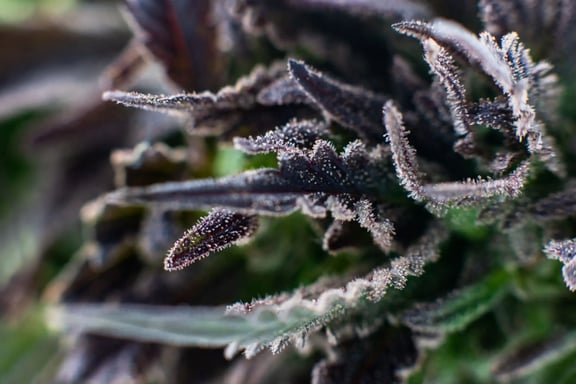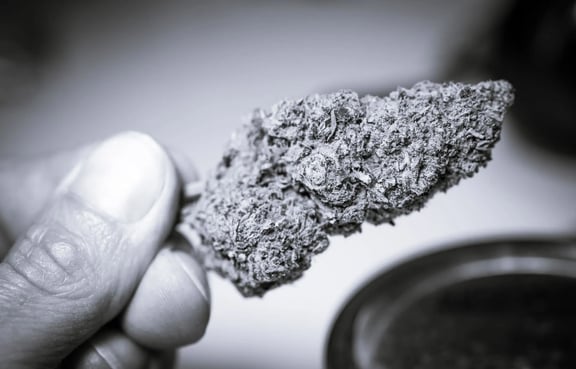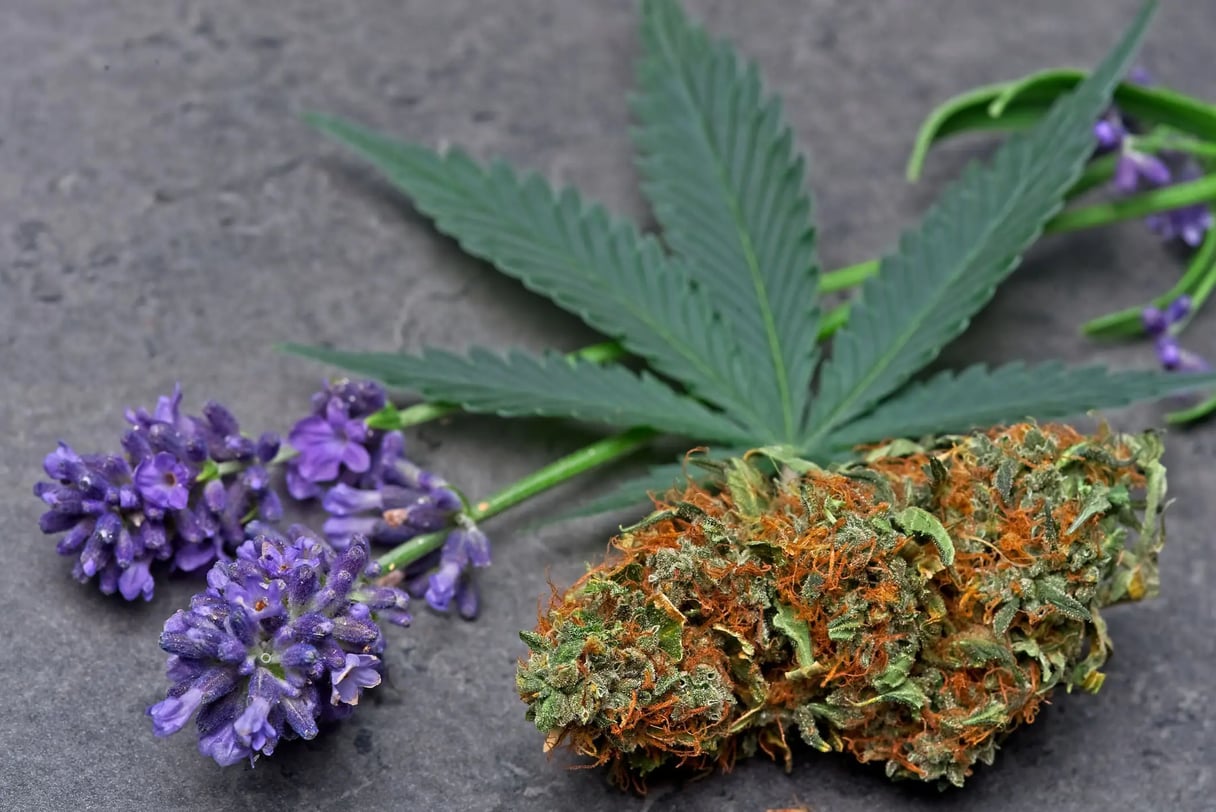Terpene Lowdown
Linalool Flavours
Citrus
Sweet
Spicy
Introduction
The Multifaceted World of Linalool: An Overview
In the sprawling and ever-evolving landscape of cannabis strains and terpenes, many components shape the user’s experience. Terpenes, the aromatic oils that give cannabis its distinctive scents and flavours, often take a back seat to the more talked-about cannabinoids like THC and CBD. Yet, among these unsung heroes, Linalool is a terpene of remarkable versatility. “Linalool is considered to be one of the oldest known sedatives, or sleep aids, in the world,” says Dr. Axe, highlighting its longstanding therapeutic benefits. This article aims to delve deep into the world of Linalool, a terpene that not only lends its aromatic charm to cannabis but also offers many health benefits.
Linalool, with its floral aroma tinged with a hint of spice, is a common terpene found in over 200 types of plants, including cannabis. “Linalool is a terpene compound found in over 200 plant species. It gives certain plants a floral aroma along with a scent of spice,” notes Dr. Axe.
But don’t let its ubiquity fool you. Regarding cannabis, Linalool plays a unique role, contributing not just to the aroma but also to the strain’s effects on the user. This article aims to be your comprehensive guide to understanding Linalool, especially its role in cannabis, ensuring you’re well-informed whether you’re a casual user or a cannabis connoisseur.

Unveiling Linalool: A Floral Yet Complex Terpene
The Chemical Structure of Linalool
In the realm of cannabis terpenes, Linalool, bearing the scientific name 3,7-dimethylocta-1,6-dien-3-ol, is a monoterpene, signifying its more straightforward structure amongst the terpene family. But don’t let the simplicity fool you. Linalool is distinctive in the vast array of cannabis terpenes, thanks to its characteristic profile and the ubiquitous presence in the plant kingdom. “Linalool, like many terpenes, is not specific to cannabis; its characteristic lavender scent with a hint of spiciness can be found in over 200 types of plants,” says Leafly, emphasising its widespread occurrence (Source: Leafly).
Isomeric Forms and Variants
The chemical structure of Linalool is fascinating in its own right. It exists in two isomeric forms, each contributing to its unique properties. The most common is the naturally occurring isomer, which contains an isopropylidene group and is often denoted as “Linalool” in the literature. The other is its isopropenyl form, which exists in a different structural arrangement. These isomeric forms add another layer of complexity to Linalool, making it a subject of interest not just for cannabis enthusiasts but also for scientific research. “Linalool has demonstrated to have a comprehensive range of bioactive properties, which can be exploited for pharmaceutic and cosmetic applications,” notes a study from PubMed, underscoring its multifaceted nature (Source: PubMed).

Historical Context
Traditional Uses and Cultural Significance
Linalool has been a cornerstone in traditional medicine and cultural practices for centuries. From the lavender fields of Provence to the ancient Ayurvedic rituals in India, this terpene has been revered for its calming and therapeutic properties. “Linalool has been used for centuries in traditional medicine practices all over the world,” notes a study from the Journal of Ethnopharmacology, emphasising its historical significance (Source: Journal of Ethnopharmacology).
In the realm of cannabis, Linalool’s historical usage is equally compelling. Ancient civilisations were likely unaware of the terpene profiles of the cannabis they used, but the calming effects of strains rich in Linalool were undoubtedly recognised. “Linalool-rich cannabis has a long history of being used to reduce stress,” says Leafly, highlighting its enduring appeal in cannabis culture (Source: Leafly).
The Nature of Linalool
Linalool is not just another terpene; it’s a complex compound with a range of properties that make it unique. Its molecular structure allows it to interact synergistically with other terpenes and cannabinoids, enhancing the overall effects of cannabis. “Linalool is a critical precursor in the formation of Vitamin E,” notes Dr. Ethan Russo, emphasising its multifaceted nature (Source: ResearchGate).
In cannabis, Linalool’s nature goes beyond its aromatic profile. It plays a role in the entourage effect, a phenomenon where the combined effect of cannabis compounds is greater than the sum of their individual effects. “Linalool has been shown to contribute to the ‘entourage effect’ of cannabis,” says a study from Frontiers in Plant Science (Source: Frontiers in Plant Science).
Origin and Natural Occurrences
Linalool’s origins are as diverse as its applications. It’s found in a plethora of plants, from the lavender fields of France to the citrus orchards of Florida. “Linalool is a major component of essential oils in several aromatic plant species,” says a study from the National Library of Medicine, highlighting its widespread occurrence (Source: National Library of Medicine).
In cannabis, Linalool is often found in strains that are known for their calming and sedative effects. Its presence is not limited to any one type of cannabis, making it a versatile terpene in the cannabis world. “Linalool is commonly found in varying concentrations in different cannabis strains,” notes Leafly, emphasising its ubiquitous presence in cannabis (Source: Leafly).
Aroma Characteristics: The Floral Symphony
Dive into the aroma profile of Linalool, and you’re enveloped in a floral, slightly spicy scent. It’s this very aroma that often acts as the first clue to the presence of Linalool in a plant or strain. “The aroma of Linalool is light and floral, reminiscent of spring flowers, but also has balancing notes of spice,” says Terpenes and Testing Magazine, capturing its aromatic essence (Source: Terpenes and Testing Magazine).
In cannabis, the aroma of Linalool plays a significant role in the overall sensory experience. It complements other terpenes and cannabinoids, contributing to a complex bouquet of scents that make each strain unique. “Linalool is a key player in the overall aroma of many cannabis strains,” notes a study from the Journal of Natural Products, highlighting its role in the aromatic profile of cannabis (Source: Journal of Natural Products).
Linalool in Cannabis
Prevalence in Different Strains
Venture into the world of cannabis, and you’ll soon realise the prevalence of Linalool in many beloved strains. This terpene doesn’t just stop at lending its aroma; it goes further, influencing the effects of the strain on the user. “Linalool is commonly found in varying concentrations in different cannabis strains,” notes Leafly, emphasising its ubiquitous presence in cannabis (Source: Leafly).
In cannabis, Linalool is often found in strains that are known for their calming and sedative effects. Its presence is not limited to any one type of cannabis, making it a versatile terpene in the cannabis world. “Strains that are high in Linalool are typically indicas, known for their relaxing effects,” says a study from the Journal of Natural Products, highlighting its prevalence in indica strains (Source: Journal of Natural Products).
The Entourage Effect: Linalool’s Synergistic Dance
Linalool plays a significant role in the entourage effect, a phenomenon where the combined effect of cannabis compounds is greater than the sum of their individual effects. “Linalool has been shown to contribute to the ‘entourage effect’ of cannabis,” says a study from Frontiers in Plant Science (Source: Frontiers in Plant Science).
In the entourage effect, Linalool works in synergy with other cannabinoids and terpenes to enhance the overall therapeutic and recreational attributes of cannabis. “Linalool can synergise with CBD to produce anti-anxiety effects,” notes Dr. Ethan Russo, emphasising its role in the entourage effect (Source: ResearchGate).
Identifying High-Linalool Strains
Identifying high-Linalool strains isn’t merely a chase for the floral aroma. It’s about tuning into a particular vibe that such strains exude. “Strains high in Linalool typically produce effects that are calming and relaxing,” says Terpenes and Testing Magazine, providing a clue for identification (Source: Terpenes and Testing Magazine).
Engaging with growers and dispensaries or relying on lab-tested products can aid in this quest. The higher Linalool content often translates to a more sedative or ‘couch-lock’ effect, making the identification worthwhile for those seeking a calming experience. “High levels of Linalool can be a marker for potential sedative effects,” notes a study from the Journal of Ethnopharmacology, offering a tip for those on the hunt for specific effects (Source: Journal of Ethnopharmacology).
Linalool Cannabis Strains
A Curated List of High-Linalool Strains
Regarding cannabis strains rich in Linalool, the options are as varied as they are captivating. From the calming effects of “Lavender Kush” to the balanced high of “Amnesia Haze,” each strain offers a unique experience. “Strains like ‘Purple Kush’ and ‘Master Kush‘ are known for their high Linalool content,” states High Times, providing a starting point for those interested in exploring Linalool-rich strains (Source: High Times).
The quest for high-Linalool strains isn’t just a pursuit of aroma; it’s a journey into a world of nuanced effects and therapeutic benefits. Whether you’re seeking relaxation, pain relief, or a touch of euphoria, there’s likely a Linalool-rich strain that fits the bill. “Strains high in Linalool are often recommended for their potent anti-anxiety effects,” notes a study from the Journal of Natural Products, guiding those who are looking for specific therapeutic effects (Source: Journal of Natural Products).
But the story doesn’t end there. Linalool’s presence in cannabis strains also extends to its potential for medical applications. Strains high in Linalool have been studied for their possible anti-inflammatory and analgesic properties, making them a subject of interest for medical cannabis research. The terpene’s potential benefits extend beyond mere relaxation, potentially offering a natural alternative for managing conditions like chronic pain and anxiety disorders.
Moreover, the strains rich in Linalool often have a complex aromatic profile, blending floral notes with hints of spice and citrus. This makes them particularly appealing to users who appreciate a multi-layered sensory experience. The aroma isn’t just a treat for the senses; it’s a clue to the strain’s potential effects. A floral, lavender-like aroma often indicates the presence of Linalool, serving as a helpful guide for those on the hunt for specific cannabis experiences.
It’s worth noting that while Linalool is prevalent in indica weed strains, it’s not exclusive to them. Some Sativa and hybrid strains also feature this terpene, albeit in lower concentrations. This versatility makes Linalool a fascinating subject of study, as researchers continue to explore its role in influencing the effects of various cannabis strains.

Beyond Cannabis: Linalool’s Broad Spectrum
Linalool in Aromatherapy
The allure of Linalool extends far beyond the cannabis plant, making a significant impact in the world of aromatherapy. Known for its calming and relaxing effects, Linalool is often the star ingredient in essential oils like lavender and bergamot. “Linalool is one of the main components in lavender essential oil, which is used extensively in aromatherapy,” states a study published in the Journal of Ethnopharmacology (Source: Journal of Ethnopharmacology).
But it’s not just about relaxation; Linalool’s potential benefits in aromatherapy extend to its possible anti-anxiety and antidepressant properties. A study in the journal Frontiers in Behavioural Neuroscience suggests that Linalool’s anxiolytic effects could be harnessed in aromatherapy to alleviate stress and anxiety disorders (Source: Frontiers in Behavioral Neuroscience).
From Lavender to Coriander: Diverse Sources of Linalool
Linalool’s versatility is further showcased by its presence in various plants beyond cannabis. From the soothing aroma of lavender to the spicy coriander kick, Linalool makes its mark in diverse botanical families. “Linalool is found in over 200 species of plants,” notes the National Library of Medicine, highlighting its widespread occurrence (Source: National Library of Medicine).
This terpene doesn’t just confine itself to aromatic plants; it’s also found in culinary herbs like basil and thyme. Its widespread presence suggests a universal appeal, whether you’re savouring a dish or enjoying the scent of fresh flowers. The diverse sources of Linalool contribute to its broad spectrum of applications, from culinary arts to traditional medicine.
Commercial Applications
Linalool in Perfumes, Cleaning Agents, and More
When it comes to commercial applications, Linalool is a jack-of-all-trades. Its floral, slightly spicy aroma makes it a popular choice in perfumes and scented products. “Linalool is used in 60–80% of perfumed hygiene products,” states a report from ResearchGate, emphasising its ubiquity in the fragrance industry (Source: ResearchGate).
But the terpene’s applications go beyond mere scent; it’s also found in cleaning agents, detergents, and even insecticides. Its versatility is a testament to its unique chemical structure, which allows it to interact with various compounds, enhancing their properties. Whether it’s adding a fresh scent to your laundry or acting as a natural insect repellent, Linalool’s commercial applications are as varied as they are numerous.
The Healthful Promises of Linalool
Anti-anxiety Potential
Linalool isn’t just a sensory delight; it’s also a promising candidate for natural anti-anxiety solutions. “Linalool reverses the anxiety-like behaviour induced by the injection of the GABA_A receptor antagonist,” states a study published in Phytomedicine journal, highlighting its potential as an anxiolytic agent (Source: Phytomedicine).
The terpene’s anti-anxiety potential is particularly relevant in the context of cannabis, where it can modulate the effects of THC, reducing anxiety and paranoia. This makes strains high in Linalool a go-to choice for those seeking a more balanced and less anxiety-inducing cannabis experience.
Antimicrobial Properties
Beyond its calming effects, Linalool also packs a punch in the antimicrobial department. “Linalool shows antimicrobial activity against a broad spectrum of bacteria and fungi,” notes a study in the Journal of Applied Microbiology (Source: Journal of Applied Microbiology).
This antimicrobial action adds another layer to Linalool’s appeal, especially in cannabis strains that are used for their potential health benefits. The terpene’s ability to fight off bacteria and fungi makes it a subject of interest for further medical research.
Anti-inflammatory Benefits
Linalool’s healthful promises extend to its anti-inflammatory potential. “Linalool has been demonstrated to exert anti-inflammatory effects by inhibiting the expression of pro-inflammatory cytokines,” states a study in the European Journal of Pharmacology (Source: European Journal of Pharmacology).
In the realm of cannabis, strains high in Linalool could offer added anti-inflammatory benefits, making them a potential choice for individuals dealing with conditions like arthritis or chronic inflammation.

Pharmacokinetics of Linalool
How the Body Processes Linalool
The journey of Linalool within the human body is a complex interplay of absorption, distribution, metabolism, and excretion, collectively known as pharmacokinetics. “Linalool is rapidly absorbed and distributed in the body, undergoing extensive first-pass metabolism,” notes a study in the journal Food and Chemical Toxicology (Source: Food and Chemical Toxicology). This rapid absorption and distribution mean that the effects of Linalool can be both immediate and potent, whether you’re inhaling it through a cannabis strain or applying it topically.
But what happens after absorption? Linalool is metabolised primarily in the liver, undergoing a series of transformations. “Linalool is metabolised to multiple metabolites, including the glucuronide conjugate of linalool,” states another study, highlighting the complexity of its metabolic pathway (Source: Journal of Agricultural and Food Chemistry). These metabolites are then excreted mainly through urine, completing the terpene’s journey through the body.
Understanding the pharmacokinetics of Linalool is not just an academic exercise; it has practical implications. For instance, the rapid metabolism suggests that the effects of Linalool may be short-lived, requiring more frequent dosing for sustained benefits. This is particularly relevant for medical cannabis patients who might be seeking long-lasting relief from symptoms like anxiety or inflammation. Moreover, the extensive first-pass metabolism could potentially interact with other medications, which warrants further research.
Safety and Toxicology
Known Side Effects and Contraindications
While Linalool is generally considered safe, it’s not without its caveats. “Linalool is not generally considered to be a skin irritant or sensitiser, but some reports suggest it may become allergenic when exposed to oxygen,” states a report from the International Journal of Toxicology (Source: International Journal of Toxicology). This is a crucial point, especially for those who are using cannabis topicals rich in Linalool or indulging in aromatherapy sessions with Linalool-heavy essential oils.
But the story doesn’t end there. The potential for Linalool to become allergenic upon oxidation means that the quality and storage of the product can significantly impact its safety profile. If you’re storing cannabis strains or essential oils rich in Linalool, proper storage away from light and air is essential to maintain its efficacy and minimise any risks.
Moreover, while Linalool is generally well-tolerated, individual reactions can vary. Some people may experience mild irritation or an allergic reaction when applying Linalool-rich products to the skin. It’s always advisable to conduct a patch test before full application, especially if you have sensitive skin or are prone to allergies.
The safety of Linalool also extends to its interactions with other substances. For instance, when used in conjunction with certain medications, particularly those that affect the central nervous system, Linalool could potentially enhance or diminish their effects. This area requires further research but is worth noting for those who are using medical cannabis flower high in Linalool for therapeutic purposes.
Scientific Inquiries and Future Directions
Current Research Landscape
The scientific landscape surrounding Linalool blends established findings and burgeoning inquiries. While there’s a wealth of research on its anxiolytic, antimicrobial, and anti-inflammatory properties, the depth of understanding still leaves room for further exploration. “The pharmacological effects of linalool have been extensively studied, but its mechanism of action is not yet fully understood,” states a review in the journal Flavour and Fragrance (Source: Flavour and Fragrance).
In the context of cannabis, the research is even more nascent. While it’s known that Linalool contributes to the entourage effect, enhancing the therapeutic potential of cannabis, the specifics are still under investigation. This makes Linalool a subject of keen interest for future cannabis research, aiming to elucidate its synergistic interactions with other cannabinoids and terpenes.
Example Studies
Diving into specific studies can offer a more granular understanding of Linalool’s potential. For instance, a study in the European Journal of Pharmacology found that “Linalool has been demonstrated to exert anti-inflammatory effects by inhibiting the expression of pro-inflammatory cytokines” (Source: European Journal of Pharmacology).
Another study in the Journal of Applied Microbiology highlighted Linalool’s antimicrobial prowess, stating, “Linalool shows antimicrobial activity against a broad spectrum of bacteria and fungi” (Source: Journal of Applied Microbiology). These studies not only validate Linalool’s therapeutic potential but also pave the way for more targeted research, especially in the realm of cannabis.
Uncharted Territories: What More to Uncover?
While the existing research paints a promising picture, it also highlights the gaps in our understanding of Linalool. Questions about its precise mechanism of action, potential interactions with other substances, and long-term safety profile remain unanswered. “Further studies are needed to elucidate the mechanisms underlying the anti-inflammatory and antinociceptive activities of linalool and the structure-activity relationships of this monoterpene,” notes a study in the journal Life Sciences (Source: Life Sciences).
In the cannabis context, how Linalool interacts with other cannabinoids to produce specific effects or potential benefits remains a fertile ground for future research. The uncharted territories of Linalool’s scientific inquiry beckon with the promise of deeper understanding and broader therapeutic applications.

Expert Opinions
Insights from Scientists and Industry Experts
The scientific community is increasingly acknowledging the potential of Linalool, not just as a fragrance compound but as a bioactive substance with multiple health benefits. Dr. Ethan Russo, a neurologist and psychopharmacology researcher, has spoken about the importance of terpenes like Linalool in cannabis, stating that they “could produce synergy with respect to the treatment of pain, inflammation, depression, anxiety, addiction, epilepsy, cancer, fungal and bacterial infections” (Source: British Journal of Pharmacology).
Industry experts, too, are keen on exploring Linalool’s potential, especially in creating cannabis strains that offer a balanced and nuanced experience. The focus is shifting from merely THC and CBD levels to a more holistic understanding of cannabis, where terpenes like Linalool play a crucial role.
Case Studies
Real-world Applications and Anecdotes
The real-world applications of Linalool are as varied as they are fascinating. From its use in aromatherapy to alleviate stress to its incorporation in cannabis strains for a balanced high, Linalool is making its mark. Anecdotal evidence often highlights its calming effects. One user on a cannabis forum noted, “I always look for strains high in Linalool; they just seem to work better for my anxiety” (Source: Reddit).
Moreover, Linalool’s antimicrobial properties have led to its use in cleaning products. A study in the Journal of Applied Microbiology found that “Linalool shows antimicrobial activity against a broad spectrum of bacteria and fungi” (Source: Journal of Applied Microbiology). This has led to its incorporation in eco-friendly cleaning products, offering a natural alternative to harsh chemicals.
Future Trends
Emerging Technologies and Methodologies
As the cannabis industry evolves, so does the focus on terpenes like Linalool. Emerging technologies are enabling more precise extraction and formulation methods, aiming to preserve the terpene profile of cannabis strains. “Advanced extraction techniques are allowing for the isolation of high-purity linalool from various sources, including cannabis,” states a report from Cannabis Science and Technology (Source: Cannabis Science and Technology).
Moreover, methodologies like terpene re-infusion are gaining traction. This involves extracting terpenes before the cannabinoid extraction process and then re-infusing them to create a product that closely mimics the natural terpene profile of the plant. This is particularly relevant for Linalool, given its potential therapeutic benefits.
Consumer Guide
Tips for Identifying High-Quality Linalool Products
When it comes to choosing Linalool-rich products, whether it’s cannabis strains or essential oils, quality is key. Look for products that have been third-party tested, as this ensures that you’re getting a product high in Linalool and low in contaminants. “Third-party testing is crucial for verifying the quality of cannabis products, including their terpene profile,” notes a report from Analytical Cannabis (Source: Analytical Cannabis).
Also, consider the source. Linalool derived from organic, sustainably grown plants is likely to be of higher quality. Whether you’re buying cannabis or essential oils, check for certifications like USDA Organic or similar standards that vouch for the product’s quality and purity.

Legal Status
The Legal Landscape Surrounding Linalool
The legal status of Linalool in the UK is generally straightforward, much like its status in other parts of the world. Linalool itself is not a controlled substance and is widely used in various industries, from cosmetics to food flavouring. However, the legal waters get a bit murky when we talk about Linalool in the context of cannabis.
In the UK, cannabis is a Class B controlled substance under the Misuse of Drugs Act 1971. This means that products containing Linalool derived from cannabis could potentially fall under legal scrutiny. It’s crucial to note that the legality of Linalool-rich cannabis products will depend on the overall THC content, which is the psychoactive component of cannabis. In the UK, CBD products, which can also contain terpenes like Linalool, are legal as long as they contain less than 0.2% THC.
So, if you’re keen on enjoying the aromatic and therapeutic benefits of Linalool, especially in the form of cannabis products, it’s essential to be aware of the THC content and the laws surrounding cannabis in your jurisdiction. Always opt for products from reputable sources that provide third-party lab tests to ensure you’re on the right side of the law.
Summary
Linalool is a terpene that wears many hats. From its calming effects and potential health benefits to its wide range of applications in products like perfumes and cleaning agents, Linalool is a terpene that deserves attention. Its role in the cannabis world is particularly intriguing, contributing to the entourage effect and influencing the aroma and effects of various strains.
In summary, Linalool is not just another terpene; it’s a bioactive compound with a wealth of potential. Whether you’re a cannabis enthusiast, a fan of aromatherapy, or simply someone interested in natural remedies, Linalool has something to offer.
Linalool FAQs:
-
Generally speaking, yes. Linalool is widely considered safe and is used in an array of consumer products, from cosmetics to food flavourings. However, it’s worth noting that some individuals may experience allergic reactions when it’s applied directly to the skin.
-
Linalool boasts a floral aroma, akin to lavender, with a subtle hint of spiciness. This unique scent profile makes it a sought-after ingredient in perfumes, air fresheners, and other fragranced products.
-
You’ll find Linalool in a variety of plants like lavender, mint, and coriander. If you’re a cannabis enthusiast, strains such as Amnesia Haze and Lavender Kush are renowned for their high Linalool content.
-
Linalool has garnered attention for its potential anti-anxiety, anti-inflammatory, and antimicrobial properties. However, it’s crucial to note that more research is needed to fully substantiate these claims.
-
Linalool itself is not a controlled substance in the UK. However, if it’s derived from cannabis, the legal status can get a bit complicated, depending on the THC content of the product.
-
Linalool participates in the ‘entourage effect,’ a synergistic interaction between various cannabis compounds that enhances the plant’s overall effects.
-
Absolutely, Linalool is a popular choice in aromatherapy for its calming and relaxing effects. It’s often found in essential oils like lavender oil.
-
While generally considered safe, Linalool can become allergenic when exposed to oxygen. It’s advisable to perform a patch test if you’re using it topically for the first time.
-
Linalool is a versatile terpene used in various products, from cleaning agents to cosmetics. Its pleasant aroma and potential therapeutic properties make it a popular choice in various industries.
-
Linalool-infused products are widely available in the UK, from high-street shops to online retailers. If you’re looking for cannabis-derived products rich in Linalool, make sure to opt for reputable sources that provide third-party lab tests.












.jpg)